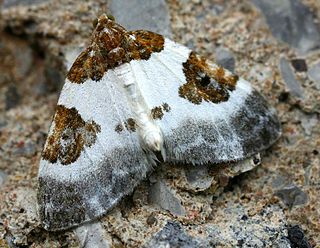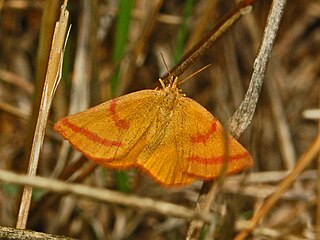
The geometer moths are moths belonging to the family Geometridae of the insect order Lepidoptera, the moths and butterflies. Their scientific name derives from the Ancient Greek geo γῆ or γαῖα "the earth", and metron μέτρον "measure" in reference to the way their larvae, or "inchworms", appear to "measure the earth" as they move along in a looping fashion. A very large family, it has around 23,000 species of moths described, and over 1400 species from six subfamilies indigenous to North America alone. A well-known member is the peppered moth, Biston betularia, which has been subject of numerous studies in population genetics. Several other geometer moths are notorious pests.

The Cidariini are the largest tribe of geometer moths in the subfamily Larentiinae. The Cidariini include many of the species known as "carpets" or, ambiguously, "carpet moths", and are among the few geometer moths that have been subject to fairly comprehensive cladistic study of their phylogeny. The tribe was described by Philogène Auguste Joseph Duponchel in 1845.

Anachloris is a genus of moths in the family Geometridae, with three species, found in Australia, New Zealand and Papua New Guinea.
Chaetolopha is a genus of moths in the family Geometridae. Most species are endemic to Australia. A number of species previously assigned to this genus, were reassigned to the new genus Parachaetolopha in 2002.

Sterrhinae is a large subfamily of geometer moths with some 3,000 described species, with more than half belonging to the taxonomically difficult, very diverse genera, Idaea and Scopula. This subfamily was described by Edward Meyrick in 1892. They are the most diverse in the tropics with the number of species decreasing with increasing latitude and elevation.

Lythria purpuraria, the purple-barred yellow, is a species of moth of the family Geometridae. It is found from western Europe to Siberia, Russia, Ukraine, Turkmenistan and Kazakhstan.

Asthenini is a tribe of geometer moths under subfamily Larentiinae first described by Warren in 1893. The tribe has been combined with Eupitheciini in the past, most notably by Jeremy Daniel Holloway in his work The Moths of Borneo.

Eupithecia breviculata is a moth of the family Geometridae. It is found in the Mediterranean region, Switzerland, Hungary, the Near East and North Africa. It is also found in Iran and Turkmenistan.
Eupithecia gratiosata is a moth in the family Geometridae. It is found in France, the Iberian Peninsula, Italy, the Balkan Peninsula, Ukraine, Poland, Russia, Turkmenistan, Kazakhstan, the Near East and Iran.

Erateina zoraida is a species of moth in the family Geometridae first described by Edward Doubleday in 1845. It is the type species of the genus Erateina, by original designation.

"Hagnagora" vittata is a species of moth of the family Geometridae first described by Philippi in 1859. It is found in Chile.

Arctesthes catapyrrha is a moth of the family Geometridae. It is endemic to New Zealand.

Arctesthes siris is a moth of the family Geometridae. It is endemic to New Zealand.

Notoreas blax is a species of moth in the family Geometridae. This species is endemic to New Zealand. This moth frequents alpine habitat and can be found in the Canterbury and Otago regions.

Notoreas chioneres is a species of moth in the family Geometridae. This species is endemic to New Zealand.

Notoreas chrysopeda is a species of moth in the family Geometridae. This species is endemic to New Zealand. It is a colourful day flying moth that lives in mountainous habitat.

Notoreas ischnocyma is a species of moth in the family Geometridae. This species is endemic to New Zealand. This species is found in Canterbury and Otago.

Notoreas isoleuca is a species of moth in the family Geometridae. It is endemic to New Zealand.

Notoreas isomoera is a species of moth in the family Geometridae. It is endemic to New Zealand.

Notoreas simplex is a species of moth in the family Geometridae. It is endemic to New Zealand.


















